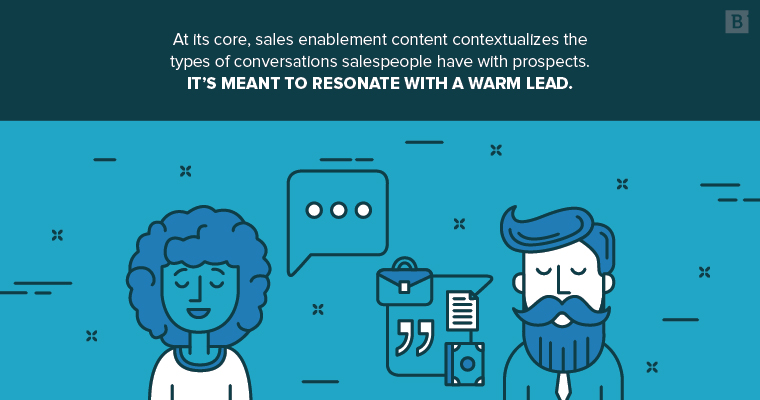Sales enablement content is sort of like gravity. You know it exists because you can observe its influence on your sales funnel, but you can’t always tangibly point to it, let alone create or wield it effectively.
Unfortunately, a lot of the information you’ll find online is steeped in nebulous jargon that may as well be quantum physics, if not complete hogwash.
Until now.
The definition of sales enablement content
Sales enablement content is any single piece of content that a sales rep can use to generate a purchase. Of course, that begs the question: Isn’t that the purpose of all marketing content?
Well yeah, but it’s the intent of the piece that makes it sales enablement content.
Think about it like courtship.
You can’t just go around proposing to strangers. You have to first initiate a conversation through an appropriate channel of communication. With dating, that might be Tinder, a cafe or a bar. In marketing and sales, it could be social media, an email nurture campaign, interactive content or perhaps a paid ad.
This is your lead-gen content, and its intent is to turn a potential customer into a lead.
Next, you need to execute a content strategy to nurture the new relationship.
Share relevant, purposeful information and ideas to pique their interest. The right content could be an analysis of something in the news. A topically relevant meme. A cool concept you’d like to see become a reality.
This is your lead-warming content, and its intent is to nudge the potential customer a little further down the sales funnel.
Now this is where things get interesting.

The objective of sales enablement content
You want to move the potential customer from the middle of the sales funnel to the bottom. This is a unique goal that is entirely separate from lead gen, or lead nurturing. It defines a piece of content as sales enablement material.
It may be a subtle distinction, but it’s important to note that content plays a unique role in different points of the sales funnel now. The function of content marketing used to stop at the consideration phase – it just needed to start the conversation and get the prospect thinking.
In the past five years or so, marketers have become more advanced in their ability to create purposeful, memorable content that cultivates actual intent to buy. This has carved out a new niche for content marketing which — you guessed it — has come to be called sales enablement content.
Types of content that support sales enablement
Sales enablement content can be just about anything — case studies, eBooks, testimonials, white papers, blog content, you name it — with a proven history of nudging a potential customer through the sales cycle.
There isn’t necessarily a recipe for what makes good sales enablement content. The ingredients are the information your salesperson collects through keyword and market research as well as customer data collection. The marketing department uses those ingredients to cook up the finished product: a polished, compelling resource that is tailor-made to assist in the transition between warm lead and closed deal.
Also bear in mind that sales content sometimes takes on a life of its own and behaves in mysterious ways. Maybe your brand awareness piece will play an unexpected direct role in the sales process.
What’s important is that you track all content, measure performance metrics and build upon past successes to establish baselines for sales enablement content.
How to create and implement an effective sales enablement content program, step by step
1. Communicate between departments
The sales department and the marketing department are unique in their areas of expertise and day-to-day responsibilities, but they have a similar goal in mind: convert leads into sales.
So, if these two teams are all working toward the same objective, shouldn’t they be working together?
To create effective sales enablement content, you need to encourage communication between sales and marketing. The sales team knows more about closed deals and sales metrics. The marketing team knows how to create quality content of all shapes and sizes.
2. Identify all stops in the sales cycle
The whole point of sales enablement content is that it exists in that sweet spot right in the middle of the sales funnel.
If you are generating one-size-fits-all content, you’re missing out on some great opportunities. The content you use to grab someone’s attention should be different from the content you use to convince them your brand is trustworthy, unique and high-quality.
Identify every point in the sales cycle for your product or service so you can generate content that is unique to every step. How will you get potential customers to notice your brand? How will you then nudge them down the sales funnel, and, finally, how will you convince them to make the final purchase?
3. Review existing content and resources
Struggling to come up with new ideas for content? You certainly aren’t the first.
You’d be surprised at how internal documents can convert to sales enablement content. Of course, there are aspects of the inner workings of your business that aren’t going to be interesting to potential customers, but some of them will be.
Turning information on sales trends or customer feedback into interactive, easy-to-read charts could give prospective clients an insight into what your business is all about.
Additionally, old content can sprout ideas for new content. Maybe you briefly touched on an interesting topic in an old blog post that you can expand upon now. Maybe you conducted a study in 2012 that could use an update with more recent numbers.
When it comes to generating ideas for content, sometimes the key is to work smarter, not harder.
4. Track sales content performance
There’s not much of a point to generating sales enablement content if it doesn’t … enable sales.
So just as important as coming up with content ideas and implementing them is tracking them to make sure they are having the effect you want.
One of the best ways to do this is through customer feedback. Send your clients surveys after they make their purchase and ask what made them choose your brand over others. Use Google Analytics to track website traffic. Use social media metrics to find out if your Instagram, Facebook or Twitter campaigns are well-received.
The relationship between sales enablement and account-based marketing
We’re certainly not the first people to encourage more collaboration between the sales department and the marketing team.
In fact, this idea led to another budding trend in content marketing called account-based marketing (ABM). In so many words, ABM is an attempt to market directly to specific accounts. Those accounts are typically prioritized by sales and then delegated to the marketer.
However (and this is a huge however), ABM is not synonymous with sales enablement content creation.
Just because you’re targeting a specific account doesn’t mean they’re a warm lead. They may have great potential, but you still need to strike up that initial conversation to get real ROI out of your sales enablement content.
Other than that?
Just remember to keep talking with your sales team. And if you’re a sales professional, share your wisdom with the marketing team.
It’s not rocket science. It’s sales enablement content.
Editor’s Note: Updated May 2021.





